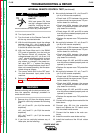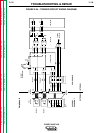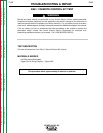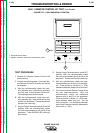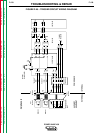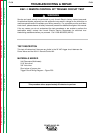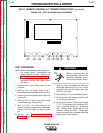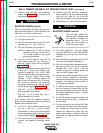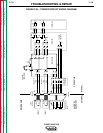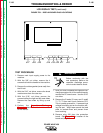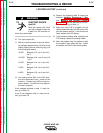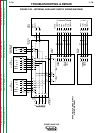
F-133 F-133
K941-1 REMOTE CONTROL KIT TRIGGER CIRCUIT TEST (continued)
TROUBLESHOOTING & REPAIR
11. Remove plug J30 from the protection
board. See Figure F.1 for location of the
board and plug J30.
ELECTRIC SHOCK can kill.
With the input power ON, there are high volt-
ages inside the machine. Do not reach into the
machine or touch any internal parts.
12. Turn input power ON.
13. With the volt/ohmmeter, check for 24 VAC
between plug J12 - pin 2 and pin 4.
A. If 24 VAC IS present, go to step 14.
NOTE: A voltage of 5 to 10 VDC is normal
between these pins without the D
to E jumper installed in the six-pin
amphenol receptacle.
B. If 24 VAC is NOT present, check for 24
VAC between plug J33 - pin 4 and pin 1.
See the Trigger Circuit Wiring Diagram,
Figure F.50.
C. If 24 VAC IS present between plug J33 pin
4 and pin 1, check the continuity and
integrity of leads #371, 374, 102C, 105B,
296, and 293 and their associated pin con-
nectors. See the Trigger Circuit Wiring
Diagram. If the continuity checks are
good, check the square wave TIG protec-
tion board by checking the continuity
through the following pins. See the Trigger
Circuit Wiring Diagram, Figure F.50.
Plug J92 - pin 6 to plug J93 - pin 5.
Normal resistance is 4 ohms.
Plug J92 - pin 3 to plug J93 - pin 7.
Normal resistance is 4 ohms.
If the square wave TIG protection board is
good, then the protection board may be faulty.
Replace the protection board.
D. If 24 VAC is NOT present between plug
J33 pin 4 and pin 1, check Auxiliary
Transformer #1, the 5 amp circuit breaker,
and the associated wiring. See the Trigger
Circuit Wiring Diagram, Figure F.50.
14. Turn input power to the machine OFF and
perform the capacitor discharge proce-
dure.
15. Remove plug J26 from the protection
board. Attach a 150 ohm resistor between
plug J26 - pin 1 and J26 - pin 2 (the J26
plug, not the header on the control board).
16. Replace plug J12 into the display board,
ELECTRIC SHOCK can kill.
With the input power ON,
there are high voltages inside
the machine, including the
protection board. Do not
reach into the machine or
touch any internal parts.
17. Turn input power ON. The LCD display
will read: ERROR: S.L. NOT INITIALIZED.
Disregard this; the test can still be per-
formed.
18. Remove the jumper between pins D and E
of the six-pin amphenol receptacle.
19. With the volt/ohmmeter, measure the volt-
age drop across the 150 ohm resistor
between J26 - pins 1 and 2. With the
jumper removed, the reading should be
zero volts (NO voltage drop).
20. Replace the jumper between pins D and E
of the six-pin amphenol receptacle.
Measure the voltage drop with the jumper
installed. The reading should be about 2
VDC across the resistor.
A. If 2 VDC is NOT present, check the conti-
nuity and integrity of leads #262 and 261
and their associated pins and connectors.
The display board may be faulty -- replace
the display board.
B. If 2 VDC IS present across the resistor, the
control board may be faulty -- replace the
control board.
21. Turn input power to the machine OFF and
connect the five leads to the main contac-
tor. Connect all molex plugs to the PC
boards and replace the cover with two
sheet metal screws. Install the machine
case sides, top, handle, and lift bail rubber
gasket.
POWER WAVE 450
Return to Section TOC Return to Section TOC Return to Section TOC Return to Section TOC
Return to Master TOC Return to Master TOC Return to Master TOC Return to Master TOC
WARNING
WARNING



